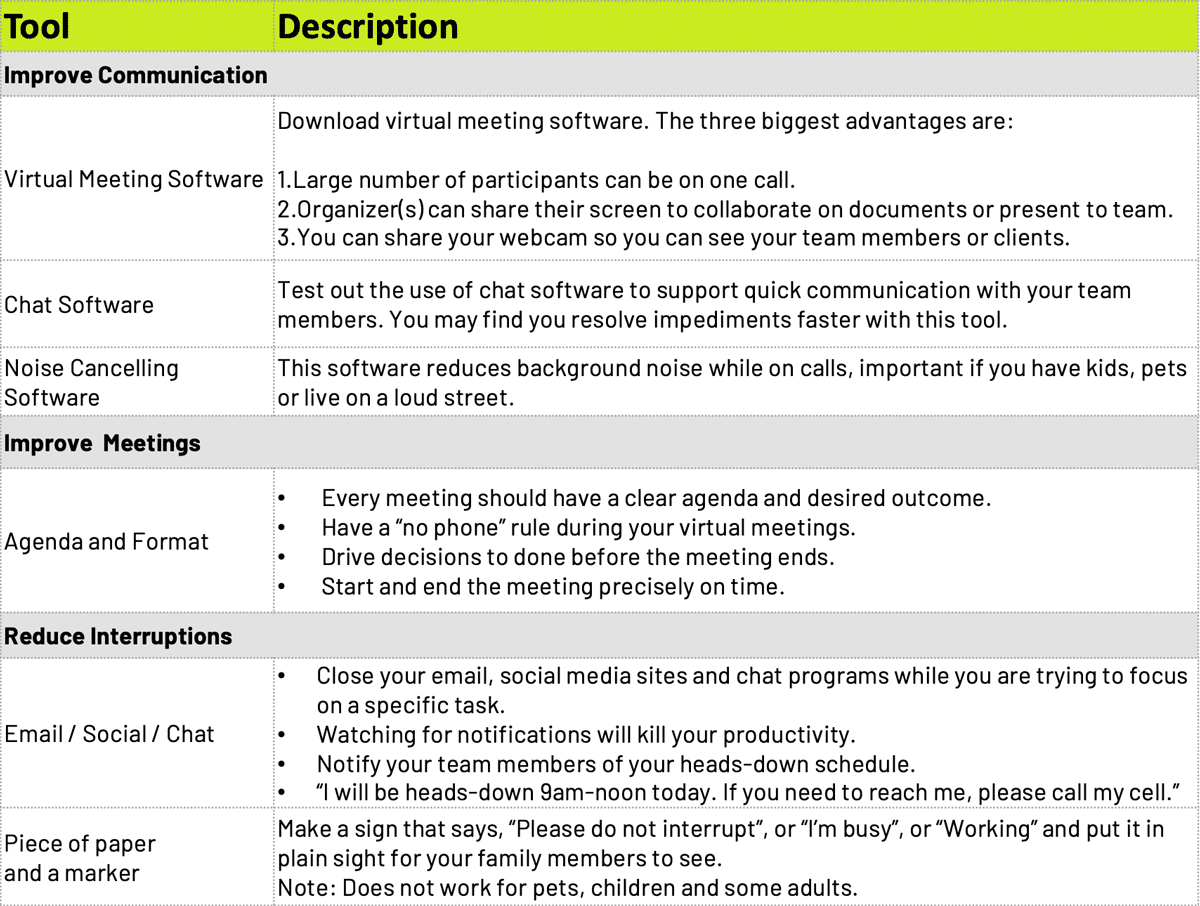You have likely had a day here or there where your child was sick, or a snowstorm, hurricane or flood forced you to stay home from work. Your only option may have been to take a sick day yourself, or perhaps you were able to get by for a day or two by working from home.
At the moment Coronavirus is getting a lot of news time, and schools and companies are talking about remote options in anticipation of containing the spread of the virus. The prospects of having to work from home for an extended period of time might be a scary prospect for you!
Don’t panic. Whether a sick child or a natural disaster keeps you from heading into the office, our 100% virtual company has remote work tips on how to be the best remote worker. At Ascendle, we have been working remotely since Day 1, as we understand the business value of being able to work from anywhere, at any time, and with anyone around the globe who will help us get our work done.
Communication in a Work From Home World
Not only does your communication not have to suffer when working from home, it can improve. If you are accustomed to working in an environment where you can poke your head around the corner and ask Sally to help you with the report you’re working on, then you might feel like your lifelines have been cut off now that you are in your home office working by yourself. Unscheduled personal interactions will disappear. Is that a bad thing? I would argue no.
Since you can’t pop in anytime to ask Sally a quick question, you will need to schedule time to meet. Since you’re scheduling time to talk, you will think about all the issues you need to discuss with her, and instead of interrupting each other 5-6 times a day, you will have one call and use that time more efficiently.
With today’s technology, there is no reason to work in a silo. At Ascendle we work with folks from 3 different continents, and we see and talk to them every day. There are many tools that support virtual communication. Zoom, GoToMeeting, Google, and Webex are all great solutions for video calls. Conference calls are great, but the ability to share video via a webcam makes the experience a much more engaging one. I do suggest that you warn people ahead of time that you will be using video so that they can shower and dress appropriately!
While I’m on the subject, being able to work in comfortable clothing is one of the best advantages of working from home. For most of my virtual meetings I wear a professional top but have yoga pants or pajama bottoms on, and no one knows the difference! To make the most of the audio experience, headsets are highly recommended. If you are worried about background noise causing disruption to your calls (I have 3 dogs who bark at every walker who passes by) consider using noise cancelling software such as Krisp.
There are other tools available that allow you and your team to “chat” and facilitate quick communication throughout the day. Slack, Microsoft Teams, and Google Chat are all good tools that fill the void when you have a quick or urgent message to send.
Meetings don’t have to be a four-letter word
Whether you’re working in the office or from home, you will likely find your schedule full of meetings. If approached the right way, these can be a very efficient use of everyone’s time. However, if the meetings do not follow a strict format, then they risk being inefficient. Here are a few tips for how to run effective meetings and get the most out of your time:
- Every meeting should have a clear agenda and desired outcome, so that no one has to ask “why am I being invited to this meeting, what is its purpose, and am I really needed?” All attendees should be aware of and working toward the desired outcome.
- Have a “no phone” rule during your virtual meetings. There should be an expectation that folks are paying attention to the meeting discussion and are not multi-tasking. Using video is a good way to hold people accountable, as it can be obvious if they aren’t paying attention.
- Issues you are addressing in the meeting should be identified, discussed and resolved, making them go away forever. Todo’s should always be documented. You should never end a meeting by saying “let’s circle back around on this” and you should never walk away wondering what, if any, next steps are required. Your goal at the end of a meeting should be either, “These are my next steps to complete this” or “This is the decision we have agreed to, thank you for helping me resolve this today.”
- Be sure to start and end the meeting precisely on time. If you have 5 people on your meeting and you start 10 minutes late then you have collectively wasted 50 minutes. As a best practice, and to mitigate the risk of connection issues when logging into your virtual meeting software, log in 3-5 minutes before the meeting starts. At Ascendle, we love to quote Vince Lombardi: If you’re on time you’re late.
Productivity
We all have our own work styles. Some of us thrive in an environment where there is a lot of noise and energy, others require a quiet space, without interruptions. You may find it difficult to find time to get heads-down work done in between your meetings. Here are a few suggestions for maximizing your time and efficiency:
- Schedule “heads down time” in your calendar, and don’t let anyone schedule meetings with you during that time.
- At the start of your heads down time, post a message via email or in the chat room letting everyone know they can call you on your phone for emergencies, but otherwise you’ll be unavailable for a specified amount of time.
- Turn off notifications and check your email and chat only occasionally, when you are in between tasks. Do not check email and chat constantly!
- If you have trouble focusing without accountability, set up a video call work session with a colleague, and work while leaving the call running. You can chat if you run into questions or blockers as you’re working.
Another great way to improve productivity and facilitate collaboration is by housing all of your documents, systems and tools in the cloud. This is essential for our global teams to access our systems. If I happen to leave my laptop in a hotel room in the last city I was in, I can go to any computer with an internet connection, log into my password management software, and I am off and running.
The Elephant in the Room: Distractions
I often have people ask me: Isn’t it too hard to work from home? Aren’t you distracted by your kids or dogs? Are you tempted to do laundry? Do you keep popping into the kitchen for snacks? Sure, you will have to get used to distractions at your house, whether it’s people or pets or chores. You may need to incorporate a little trial and error to find what best works for your situation. This may mean altering your working hours to maximize when the house is quiet, or being strict with your family members about when you can and can’t be interrupted.
One method you might consider is the tomato-timer technique, also known as The Pomodoro Technique. You set a timer for 25 minutes to work on a specific task, where you do not allow yourself to be distracted by anything. You should not look at your phone, get a glass of water, go to the kitchen or answer the door.
It’s important to be realistic with yourself and your team members. If you are required to work from home for a snowstorm or illness, your family members are likely home as well. It may not be realistic to put in 8 hours a day. Your team should be transparent about that and work together to support the heads-down time and meeting times that will work best for everyone. The good news is that more and more companies support open communication and flexible work arrangements.
Turn Lemons into Lemonade
At Ascendle, we are accustomed to working virtually, and all of our systems and tools are designed to support it. If you suddenly find yourself forced to work from home not by choice but by some external factor, you may be feeling a little overwhelmed. Try to look on the bright side. Stay open-minded to the value it may bring to yourself or your team members.
Not everyone requires the same environment to be productive. Use this opportunity to have conversations with your team members about the pluses and minuses of working from home. You may find there is value in implementing virtual weeks every now and again because of the benefits your teams realized while testing it out. Each individual team member will have a strong opinion if it would work for them in the long run. Leave room for the discussion!
At Ascendle, we have seen increased productivity by working virtually. We save hours each day by not having to get in the car to commute back and forth to an office. We make more efficient use of our time during meetings. Lunch breaks are a walk to the kitchen rather than a drive to the restaurant to wait in line. Employees are able to work during hours that make sense for them and their personal situations. Most of all, they can still get their work done even if they can’t make it into the office.







